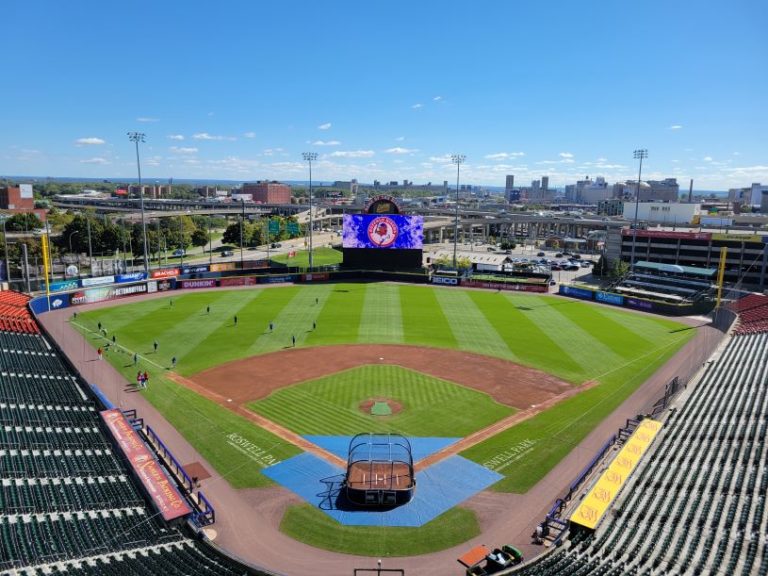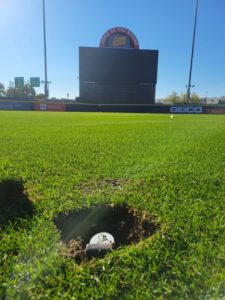By Kelly Rensel, CSFM
Over the last 20 years or so, the game of baseball has drastically become more data driven. Launch angle, velo and spin rate have now entered the baseball lexicon, and have driven a wedge between baseball fans. The old-school baseball fan thinks the “stat nerds” are taking over the game, and the new-school data-driven fan thinks that gramps can’t keep up with the new game. This is becoming true in the turfgrass world as well, and we need to marry both concepts to better manage our fields.
The old-school way of walking the field every morning, using our eyes to inspect any damage, and just talking to coaches, staff and our athletes is the lifeblood of our operation. Adding in some of the newer pieces of technology to supplement those practices can help us achieve better results. If the people in the front offices and clubhouses can use newer data and technology to understand and explain the game, why can’t we?
Data and technology can help us better communicate to those who don’t speak the language of dirt. This can help us translate the dirt talk into something others can understand and digest better. Also, these newer innovations can help us on the labor and budget fronts, and allocate those resources better to improve our operations. It also can’t hurt to have numbers and data points from these newer innovations in your back pocket – instead of just some pretty adjectives to explain wants or needs.
One of the newer pieces of technology that has really gained ground during the last few years has been the emergence of soil sensors. These sensors give you the data for temperature, moisture, salinity and electrical conductivity. Most of these sensors either have a mobile app or website to store the data or upload it to. Soil sensors come in two different types: in-ground and portable. In-ground sensors must be installed at a depth that you decide, and are semi-permanent. They can be moved to another desired location but that requires digging them up again. Portable sensors can check any spot at any time; but, unlike in-ground sensors, you can’t get up-to-the minute data when away from the field. Being able to monitor your field from afar can take some strain off you and your staff.
This year I added in-ground Soil Scout sensors to Sahlen Field. The sensors drastically changed how I looked at managing the playing surface, and took all the guesswork out of the job. Instead of saying to myself, “Meh, we look good. I don’t need to run irrigation tonight,” it turned to “I need to run irrigation tonight because my moisture percentage is at x% and it needs to be at y%.” Also, adding a sensor in the infield skin helped keep that surface consistent; and knowing what the data says during rain events assisted in better decision making on when to tarp or how much longer we could keep playing during a rain event. Also, I could set alerts and have the sensors tell me when I need to run irrigation. One tip for in-ground sensors is to mark them between irrigation heads and add them to the irrigation diagram so they can be located and flagged before aerating or any cultural practice.
Along with adding soil sensors, I installed another simple piece of technology to assist in decision making: a personal weather station. I know it’s not something new or the latest and greatest, cutting-edge technology, but it is something that can make decision making and future planning easier. There are thousands of different kinds of weather stations out there, so do your homework and choose the one that best fits your budget and your needs. Most, if not all, weather stations have WiFi connections, mobile apps, and a separate touchscreen display. The stations can give you up-to-the-second data on temperature, wind speed and direction, rainfall amounts, humidity, dew point, and wind chill among all the weather information you desire.
The biggest use for my Atlas weather station was collecting accurate rainfall data. Using accurate rainfall data combined with the soil sensors made decisions about running the irrigation very easy. Also, being away from the park and knowing how much – or how little – rain we received helped me sleep a little easier. Being able to know what the wind speed is to judge when it’s too dangerous to pull tarp and if it’s too windy to make a spray application assisted greatly in decision making. Having accurate temperature reads helped when keeping track of growing degree days for growth regulator applications.
The last piece of technology that I used this year was the Carta GPS measuring wheel. I know we all have used Google Earth and measured out our fields – and that works accurately. The Carta measuring wheel greatly assisted in knowing how much sod to order by being exactly on the area that is going to be replaced, instead of making a guess on a computer. One of the more convenient features was the ability to store the measurements for different projects separately on the mobile app instead of using pen and paper. It also has a built-in materials calculator if you need to make estimations on the fly.
As always with newer technology, be prepared to be frustrated with bugs and hiccups along the way. Always make sure you have good WiFi and/or cell service, check the batteries frequently, and keep your sales rep’s number on speed dial. You’ll probably need to talk with them often to figure out the kinks, if they arise, as your bumps in the road will help them improve the products.
Using these pieces of technology can certainly make our jobs easier. I remember in my first year of working MiLB (2008), we would print out a screenshot of the radar and show the umpires what was coming. Now that seems like ancient times, because we can go out to the umpires with a smartphone or tablet to instantly show them the radar and forecast.
A lot of innovations might seem tough to get behind at first because there hasn’t been much field testing of them. I get that not all these newer tools are for everybody, as we all have different circumstances and budgets, but we should keep an open mind about them. With all the newer innovations coming out, it certainly feels like Skynet might go live at any moment with all the robots driving and flying around. But I can assure you that they won’t be completely taking over just yet, they’re just here to help.
Kelly Rensel, CSFM, is the head groundskeeper for the Buffalo Bisons, the AAA affiliate of the Toronto Blue Jays. He has worked in Minor League Baseball over the last 15 years and has a Sport Administration degree from Edinboro University of Pennsylvania. Follow him on Twitter at @kelren31.



